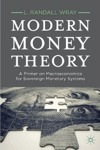By
L. Randall Wray
For most of my career—going on 30 years–I’ve been accused of advocating Big Government. That is mostly because I adopted Hyman Minsky’s views—which I won’t go through here. Of course, those claims came from the right. I’ve always been proud of it, to some extent, even if I’ve always been critical of what my government actually does with its spending. And if I don’t piss-off at least one person every day, I’ve failed.
For the past 20 years as we developed the MMT approach and the JG/ELR proposal, we’ve faced all manner of ridiculous accusations: we advocate slavery (offering a job to someone who wants to work is no different from chaining him and whipping him and forcing him to pick cotton in the hot sun from sunrise to sunset) or communism (proposing full employment as a policy goal is the same thing as forcing everyone to share their undergarments) or fascism (noting that taxes-drive-money is equated to herding Jews into gas chambers).
Of course, those claims came mostly from the left—indeed, all three were proclaimed in the same sentence by a prominent Post Keynesian, and repeated at every opportunity by him and all his followers.
And now there is a whole website devoted to an “alternative” modern money view (called MMR—which I’ve not been able to decipher; it either stands for
Measles, Mumps, and Rubella, or Monetarily Mentally Retarded—neither is very PC as an identity, I must say) insisting that the MMT approach embraces Nazi authoritarianism, since as we all know, no democratic government would ever impose taxes, much less use them to drive money (nay, according to MMR everyone would sit around leaderless campfires and barter with seashells whilst singing Kumbaya). Oh and then there is the guilt by association: some financial markets people as well as Austrians agree with some of MMT, thus, MMT has to be an evil plan developed by Goldman Sachs to take over the world. This is the view of both right and left critics.
And now we find ourselves accused of advocating Small Government. The ultimate insult!
In a bizarre twist, the critics have been able to combine the guilt-by-association (some MMTers actually are willing to discuss Austrians views! Oh my, what has the world come to?), ad hominem attacks (a hedge fund manager must be against government!), and faulty logic (explaining how a JG is an automatic stabilizer must mean you are against discretionary fiscal stimulus!) to come up with yet another attack—and, again by Progressives (obviously—since Austerians want smaller government, so presumably they welcome us to the Small Government fold!).
I don’t think either our Austerian friends or our Progressives have the foggiest notion how big the federal government now is, what it spends on, and how much greater spending would need to be to fund all the programs Progressives want (and that Austrians fear).
I don’t know if this is going to make me more of a Big Government type or enhance my newly found Small Government reputation. But let’s see what the Federal government actually spends, using 2010 data (latest more-or-less actual data from the 2012 Economic Report of the President). The total is $3.5 Trillion, which is 24% of GDP that reached $14.66 Trillion.
Note that this is unusually high compared to trends due to the “big spending Democrats in the White House”.
No, actually it is big because GDP was depressed by the deep recession while government spending rose mostly automatically to deal with unemployment, poverty, and medical problems brought on by the crash.
But let’s take 24% of GDP as a rough approximation of the size of our “Big Government”. Note I am not including state and local governments—these are users, not issuers of the currency. Their spending is “paid for” by taxes, fees, fines, and some funding from Washington. I can see arguments either way for including them in our measure of the size of “Big Government” but I think that from the MMT perspective it makes more sense to leave them to the side.
I have added in parentheses the percent of GDP for the biggest items: defense (5%), Education and so on (1%), Health (2.5%), Medicare (3%), Income Security (4%), and Social Security (5%). Nothing else really matters much individually. Note there are well-known problems with the defense number—the reported figure significantly understates actual spending because a lot of “defense” activities are secret; some of the spending is hidden in other categories. Some is probably not reported anywhere.
2010 FEDERAL GOVERNMENT OUTLAYS BY FUNCTION ($Millions)
Total: On-budget and off-budget …………………………………. 3,456,213 (24%)
National defense …………………………………………………………….. 693,586 (5%)
International affairs ……………………………………………………….. …45,195
General science, space and technology ………………………… ….31,047
Energy ………………………………………………………………………. ……..11,613
Natural resources and environment ……………………………… ….43,662
Agriculture ………………………………………………………………… …….21,356
Commerce and housing credit …………………………………… ….–82,298
Transportation ………………………………………………………………… 91,972
Community and regional development …………………………. …23,804
Education, training, employment, and social services ……..127,710 (1%)
Health ………………………………………………………………………. ……369,054 (2.5%)
Medicare ………………………………………………………………….. ……451,636 (3%)
Income security ……………………………………………………………….622,210 (4%)
Social security …………………………………………………………… …..706,737 (5%)
Veterans benefits and services …………………………………….. .108,384
Administration of justice …………………………………………….. ….53,436
General government …………………………………………………… ……23,031
Net interest ………………………………………………………………….. ..196,194
Undistributed offsetting receipts ……………………………………–82,116
OK for our conservative and Austrian Austerians, a government that is almost 25% of our economy is far too big. For our progressive friends it is far too small. Let’s focus on the big things.
At least a fifth of all government spending goes to “defense”—and the actual figure is probably double that (say, 10% of GDP). Judging from libertarian support for Ron Paul and from the traditional progressive opposition to US imperialism abroad, I suspect we can agree that “defense” spending is far too big. Personally, I have opposed all US invasions of other nations with the exception of our participation in WWII. I’d bring all troops home, close all foreign bases, and prohibit further military adventures abroad; as our Republican friends say, “starve the beast” by cutting all military spending down to what is necessary to maintain a purely defensive force within our borders. The only foreign intervention I would support would be to air drop food and medical supplies wherever they are needed.
I know I won’t get my way. I would not call this a Big Government or Small Government preference—it is anti-war. But let us presume we scale back “defense” spending to a scale that makes it hard to mount sustained invasions abroad—to, say, 2% of GDP. (That should be sufficient to put a tank into the hands of every gun-loving and motherland-protecting patriot to ward-off attack.) We’ve thereby reduced the reported size of government by 3% of GDP (and perhaps actual size by 8% of GDP—but we will ignore that in calculations below). So, a 3% reduction of Big Government.
MMTers want a universal Job Guarantee program at a living wage. Various calculations have put that at about 1% of GDP, with net cost close to zero (due to savings on anti-poverty programs, unemployment compensation, and so on). Let’s say that is off by an order of a three hundred percent—true cost turns out to be 3% of GDP. That just replaces the reduction of defense spending, getting us back to 24% of GDP.
Now it is unreasonable to presume there is absolutely no reduction of “welfare” spending—in the form of “income security” that is 4% of GDP. We’ll offer a job to all who want to work, creating somewhere between 10 million and 30 million new jobs at a living wage (note that not all of the new jobs will be in the JG program—that depends on “multiplier” job creation in the private sector, but those jobs will also pay living wages or otherwise workers cannot be recruited out of the JG). Unemployment compensation, food stamps, and even some “tax expenditures” on the earned income tax credit will all decline.
Stephanie Kelton and I have replicated earlier work done by Hyman Minsky showing that a JG program will eliminate most poverty (defined as those below the official poverty line) just by providing one minimum wage job per household. At a higher wage, and by offering more than one job to households that want more work, the JG would raise most families well above the poverty line. Let us say that income security spending falls by a couple of percentage points (2% reduction). That offsets two-thirds of the JG program spending.
Note also there will be a bit of saving in the “education, training, employment, and social services” category that currently prepares workers for jobs that do not exist. But let’s keep the 1% devoted to that spending but instead prepare workers for jobs that will exist. So I won’t count any reduction here.
So we are down to 22% of GDP. Now let’s replace our failing US healthcare system with a universal and free, federally paid-for program that offers the range of services that are provided in the average rich nation. That will run about 7-8% of GDP. We already devote an amount equal to 5.5% of GDP to “health” and “Medicare”. Then there’s another 10% of GDP spent by consumers either out-of-pocket, through their state and local governments (“taxpayers”) and through private insurers. So we can cut total spending if we ramped up federal spending by a couple of percentage points. We’ll presume that extraordinary health spending (vanity nose jobs, anatomical augmentation, hair transplants from hairy backs to shiny scalps, etc) is taken care of by the private sector, while all the important stuff is covered by the federal government.
Let’s leave the savings to the nongovernment sector spending to the side and focus on the government’s portion: we go from 5.5% of GDP to, say, 8% of GDP for an increase of federal spending equal to 2.5% of GDP.
The remaining big category is Social Security—about three-quarters of which goes to retirees. That is the main income support for the majority of our seniors. Progressives believe benefits are too small—especially for retirees who had low earnings, and also for many who receive disabilities as well as for dependents and spouses of workers who die. Let’s ramp that up by 2% of GDP.
Note that with the JG program discussed above, that offers a living wage to all who want to work, seniors and their dependents will already have the option of earning more income from work. We should let them “double dip”—no reduction in work opportunity due to retirement onto Social Security benefits, nor in Social Security benefits should they choose to work. Living standards should be significantly higher with the boost to benefits plus the enhanced jobs prospects.
Our net impact on federal government spending so far: net increase of 2.5% of GDP. We’ve gone from a Big Government of 24% to 26.5%.
But we aren’t done yet. Let’s look to our progressive wish list for more. Public infrastructure is deficient—a point made by President Obama, and by our society of engineers that finds a deficit in our public infrastructure amounting to trillions of dollars. Yes we need bullet trains, cleaner water, better airports, bridges and hiways, and more dependable sewage treatment. And we need to join the developed world in getting our darned electrical wires safely underground so that power isn’t knocked out in every ice storm.
How much? Let’s look to the estimates provided by the progressive PERI
report. They found that the rate of growth of public infrastructure spending fell by about half over the past decades; they project a needed “baseline” annual increase of $87 billion to make up for the shortfall, of which $54 billion would come from all levels of government.
Their “wish list” high end estimate would be for the public sector to spend even more, an additional $93 billion annually. However our state and local governments are broke—so let’s put the full burden on the federal government, and ramp up its spending by 1% of GDP (make it a nice round $150 billion per year). That is well above the PERI dreams—which will go beyond traditional projects and make a dent in our sustainability problems with insulation retrofitting and so on. (There is a nice synergy here as our JG workers will be doing these sorts of projects.)
So we add another percentage point to government spending.
Our Big Government is now 27.5% of GDP. We’ve got true full employment at a living wage. We’ve got universal and free healthcare. We’ve got a more generous retirement system, and better care for survivors and those with disabilities. We’ve got bullet trains and bridges that don’t fall into rivers. And we’re reducing our foreign entanglements.
All for 3.5% of GDP additional spending.
And we’ve avoided “dynamic budgeting”—we have not counted potential savings in terms of reduced incarceration for the young jobless males who turn to a life of crime. We haven’t counted health benefits; we didn’t reduce spending very significantly on income support that will face fewer demands. We didn’t count multiplier effects on private sector spending—that would reduce government spending in some areas. And so on.
All of us, progressives and Austrians alike, know we can “afford it” because a sovereign government cannot run out of its own currency. Three point five percent.
I do not know if that will comfort our Austerians, who think 24% is already far too big. Nor do I know if it will comfort our Progressives, who are now sure that MMTers have become advocates for Small Government.
To be sure, I can add some more items to the list above: more federal funding for education, federal support for sustainable agriculture (but less support for corporate farming—so that probably balances), more foreign aid, and good wine flowing from every water fountain in America.
All that might add one or two or three more percent—and get us to a 30% government. Will that horrify our Austrians, and still dissatisfy our Progressives?
Probably. Both.
What should government do?
I think reasonable people can disagree when it comes to what government ought to do. I think it is worth discussing. Lay it out on the table. Forget the silly arguments about deficits and hyperinflations and taxation by dictatorships and JG slavery and bankrupting our grandkids and associating with Austerians and Hedge Fundarians.
And about arbitrary government-to-GDP ratios. We don’t need to argue about whose is bigger. What matters is what you do with government.
What should government do? It’s a mostly political question. A 24% government (US) can do most of what most people seem to want government to do. And more than what others want. And so can a 50% government (France). The jury is still out on a 15% government (Mexico)—it would be hard to point to Mexico as either a case of a successful government doing what people want it to do, or as an Austrian Austerian utopian Small Government.
What do you want government to do?











